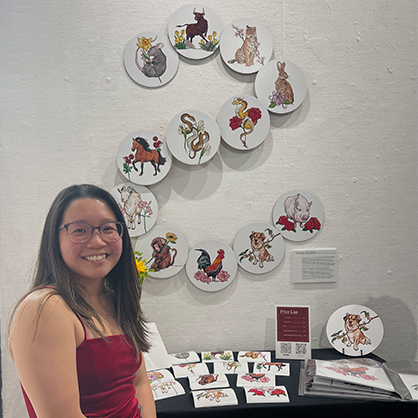
Nichole Licata ’23
‘The lesson of elevating your art’
The role of a graphic and digital designer is to shape and color the tidal wave of information that fills our media-heavy world – from print, to video, to web, to the ever-changing elements in interactive media.
As a graphic and digital design major at the University of New Haven, you’ll learn to create compelling visual communications that cut through the information clutter.
Our faculty are leaders and innovators in their fields, bringing both deep professional experience and academic rigor to the classroom.

‘The lesson of elevating your art’

The work I did for my thesis has impacted my goals significantly.

This is an exciting opportunity, and it can change an artist’s career.
Animators and Multimedia Artists
1.6% Growth 2024-2034
Graphic Designers
2.1% Growth 2024-2034
Marketing Managers
6.6% Growth 2024-2034
This course covers the conceptual skills and issues pertaining to the design of interfaces for digital products. A comprehensive investigation of the interface design process will be covered, including designing interfaces that are meaningful to users and applicable to a range of contexts: web, mobile, desktop, and beyond. Emphasis will be on aesthetic issues such as iconography, layout, colors, and typography. Site evaluation, content, structure, audience, and industry best practices are also emphasized. Current applications such as HTML editors and app makers will be discussed and implemented to design interactive projects. A survey of the design of interfaces that involve physical elements (e.g. appliances, consumer devices, etc.) will also be introduced.
This course will educate students on how to conceive and execute projects for non-profit organizations. Graphic Design is crucial for non-profits to successfully raise awareness, promote campaigns, and build an audience for their causes. This class invites students to use their creative thinking skills to frame challenges, seek opportunities, and offer innovative ways of communicating on the topic. Emphasis will be on non-profit organizations as clients allowing for service learning and exposing students to projects with real-world outcomes that directly impact peoples’ lives.
Service learning is a credit-bearing, educational, experience in which students participate in an organized service activity that meets identified community needs and reflects on the service activity in such a way as to gain further understanding of course content, a broader appreciation of the discipline, and an enhanced sense of civic responsibility.
This course examines how traditional boundaries between artistic and technological disciplines have been blurred. The course focuses on the ideas, movements, and technological/artistic practice which have guided new media aesthetic and arts movements through the 20th century. Students will develop an understanding of new media, analyzing historical trends and seminal work in the media arts and information sciences, as well as the language and aesthetics unique to new media.
This course is an advanced design seminar in which students develop an individual project in the topic of their choice. Each student will complete a coherent package of advanced graphic design work, culminating in a group design project exhibition and design research paper. This semester-long project is designed to encourage extended development and synthesis of communication skills and is related to design disciplines. The Thesis should represent a significant body of independent creative work. It can take many different forms or combinations of forms: digital or print publication, web and apps, packaging and installation, or motion graphics.
The University of New Haven offers a wide variety of in-depth courses that create a transformational educational experience for our students. To view the complete list of courses you'll take while pursuing a Bachelor of Fine Arts in Graphic and Digital Design, check out the Academic Catalog:
Get an inside look at what differentiates the University of New Haven and how your experiences as a student will prepare you for success.



All University of New Haven students have access to the many resources available through the University’s Career Development Center, which has been named one of the best in the nation by The Princeton Review.
From career assessments, networking, and job shadowing to on-campus interviews and salary negotiation, the Career Development Center provides the skills and connections to identify a meaningful career and an opportunity to pursue your passion.
Learn More
The University of New Haven has achieved the National Association of Schools of Art & Design (NASAD) accreditation. This mark of excellence designates the University's B.A. in Art & Creative Technology and B.F.A. programs in Graphic and Digital Design, and Interior Design as nationally accredited programs.
Founded in 1944, NASAD is an organization of schools, conservatories, colleges, and universities with approximately 360 accredited institutional members. It establishes national standards for undergraduate and graduate degrees and other credentials for art and design and art/design-related disciplines, and provides assistance to institutions and individuals engaged in artistic, scholarly, educational, and other art/design-related endeavors.
Learn More
University News
As part of the University's profile, students described the Charger community as "caring and considerate" and said among its signature majors are many "amazing programs you cannot get anywhere else."

The Charger Blog
A group of art and design majors recently displayed their senior capstone projects as part of an exhibition in the University's Seton Gallery.
There are a variety of opportunities for you to learn more about our programs, what it is like to be a student here, and the scholarships, assistantships and financial aid that we offer. Whether you want to meet us on campus or online, we have something for you.
Whether you're still in high school or are transferring from another college, we offer full- and part-time opportunities for undergraduates from inside the U.S. and abroad. The admission process can begin as early as the end of your high school junior year.
The Application Process
We offer a comprehensive financial aid program, with students receiving assistance in the form of grants, scholarships, student loans, and part-time employment. Funds are available from federal and state governments, private sponsors, and from university resources. More than 85 percent of the University's full-time undergraduate students receive some form of financial assistance.
Learn More